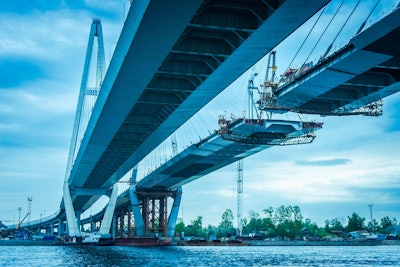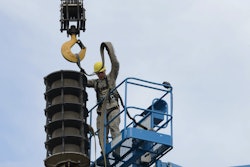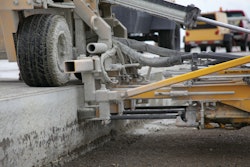
Like an X-ray is used to see inside the human body, non-destructive testing (NDT) can be a powerful and effective means of understanding a bridge’s structural integrity without damaging the structure—and the key to achieving greater structural health, efficiency and safety on large-scale projects.
But sometimes, common NDT tools–from ultrasound and dye penetrant, to eddy current and magnetic particle testing, can be a “knee jerk” reaction—and get misapplied by those not as familiar or conversant with these tools and their purpose. When it comes to bridge safety, here’s how to know what NDT techniques to use and when.
Testing and Inspection
Inspection is an effective way for project owners and decisionmakers to ensure infrastructure is built to code and to ensure greater project quality. Inspection is also mandated on federal and state levels to uncover flaws or possible problems with the structure, with a goal of identifying problems now so they can be ameliorated.
While visual inspection and examination is technically an NDT method, too often more advanced NDT tools and technology are implemented in its place. You don’t want to order NDT tools for something that should be a visual inspection; when you need enhancement to your visuals, these tools become valuable, but a wholesale employment of NDT is not appropriate.
Decisionmakers must ask, is a battery of NDT testing going to be valuable, and is it going to provide information that is going to be worth the time and money spent to obtain it? If there is no real reason for it, it probably is not necessary or well advised. A qualified NDT partner will be able to identify which parts of the project require more in-depth NDT tools and which do not.
Avoiding Catastrophe
Nondestructive testing can provide critical evaluation and inspection insights for most, but not all, bridge projects. The following are three of the most significant highway bridge collapse events that have occurred in recent history.
First, the I-35w Bridge over the Mississippi River in Minneapolis, Minn., August 2007. The bridge was eight lanes wide, and approximately 1,000 ft. of the total 1,907-ft. length of the structure collapsed, 456 ft. of which fell over 100 ft. into the Mississippi River below. As a result of accident reconstruction and analysis, investigators recommended the “use of nondestructive evaluation at locations where visual inspections may be inadequate to assess and quantify such conditions as section loss due to corrosion.”
Second, the I-95 Bridge over the Mianus River, in Greenwich, Conn., June 1983. The 100-ft-long suspended span of the eastbound traffic lanes of the Interstate Route 95 (I-95) highway bridge collapsed and fell 70 ft. into the river below. The National Transportation Safety Board determined that the probable cause of the collapse was the undetected lateral displacement of the hangers of the pin and hanger suspension assembly in the southeast corner of the span, by the corrosion-induced forces. It was noted that this was exacerbated by deficiencies in the bridge inspection and maintenance.
Third, the Silver Bridge over the Ohio River, in Point Pleasant, W.V./Gallipolis, Ohio, December 1967. The safety board determined the bridge collapse was the cleavage fracture in the lower limb of the north eyebar suspension chain. The fracture was caused by the development of a critical-size flaw over the 40-year life of the structure as the result of the joint action of stress corrosion and corrosion fatigue. It was concluded that the location of the flaw was inaccessible to visual inspection; and the flaw could not have been detected by any inspection method known without disassembly of the eyebar joint. The disastrous collapse of the Silver Bridge highlighted the dangers of not having a comprehensive and standardized bridge inspection system. In 1968, the U.S. Congress revised the Federal Highway Act of 1968 to establish a National Bridge Inspection Standard and create a program to train bridge inspectors.
As a result of the post-event investigations, there have been numerous recommendations proffered with the intent of preventing any future catastrophic failures, many of which have been codified. There have no doubt been many situations where these measures have identified a problem and perhaps helped to avert a disaster. However, the specter of another structural failure is always lurking, and the elimination of further catastrophic events remains elusive.
With more recent bridge failures, from the Fern Hollow Bridge collapse in Pittsburgh to the Hernando De Soto broken steel structural member, in-service inspections are vitally important to ensuring a bridge’s safety and avoid catastrophe.
Periodic In-service Inspections
According to the American Society of Civil Engineers (ASCE), there are more than 617,000 bridges across the United States, 42% of them over 50 years old, and 46,154, or 7.5% are structurally deficient. Federal and state law mandates that bridges must be inspected at least once every 24 months, and that defects be repaired.
Routine in-service bridge inspections include visual inspections, which often focus on areas where there is significant potential for flaws or cracks to develop. Technicians will review these areas, and the entirety of the bridge structure, visually to check for flaws, cracks and imperfections of any kind. Oftentimes, visual inspection is enough to determine the structural health of a bridge.
Understanding NDT Tools
Using both visual and nondestructive inspection methods, cracks and other areas of concern may be uncovered. Inspection results help us understand which areas of the bridge need maintenance, as well as remaining service life. Inspection helps to determine the overall bridge condition, enabling informed decisions about bridge replacement or rehabilitation.
The engineer of record is responsible for determining the severity of cracks. If, for example, a crack has propagated through 10% of the material thickness versus 50% or more. If it’s only propagated through 10% of the material thickness, we may have time to come back and measure it later and see if it has advanced. If it has propagated 50%-60%, it may need to be replaced. NDT tools show the severity of a crack or flaw, and how urgently it must be repaired.
In addition to visual inspection, the most common NDT tools for bridge testing include ultrasonic testing, dye penetrant, magnetic particle testing and in many cases, eddy current. These techniques help us determine if there are cracks present.
Where Do Bridge Defects Come From?
The ASCE estimates there are 178 million trips over structurally-deficient bridges every day. Bridges can deteriorate if not maintained and tested regularly. Fatigue failure, or propagation of cracks due to a repetitive load, is the most common reason. The ongoing stress levels induce imperfections in the bridge structure, which grow into cracks. These cracks increase in size over time and can result in structural failure.
The cost to conduct investigations on bridges can be substantial, and even with an estimated $27 billion of the recent infrastructure bill going toward bridges, there will still be significant budgetary constraints. Cost effectiveness with governmental bridge owners is still a big deal.
Civil engineers know enough to design things and understand bridge behavior under load, but when further investigation of a potential problem appears necessary, the selection of ancillary NDT methods is often beyond the purview of design professionals. Always take the risk of erring on the side of being cautious.
23 CFR 650 is the national bridge inspection standard, and each state must conform to this code, with 23 different metrics they must follow. Safety is a hugely important part of meeting federal requirements.
Government groups and bridge decision-makers want to get the most bang for their buck with bridge inspections, and nondestructive testing is an effective means to inspect and assess the condition of bridge structures.
But like so many other powerful tools, NDT must be used appropriately and not reactively for it to be effective. When used properly, NDT can be one of the most powerful tools in the inspection toolbox.



















